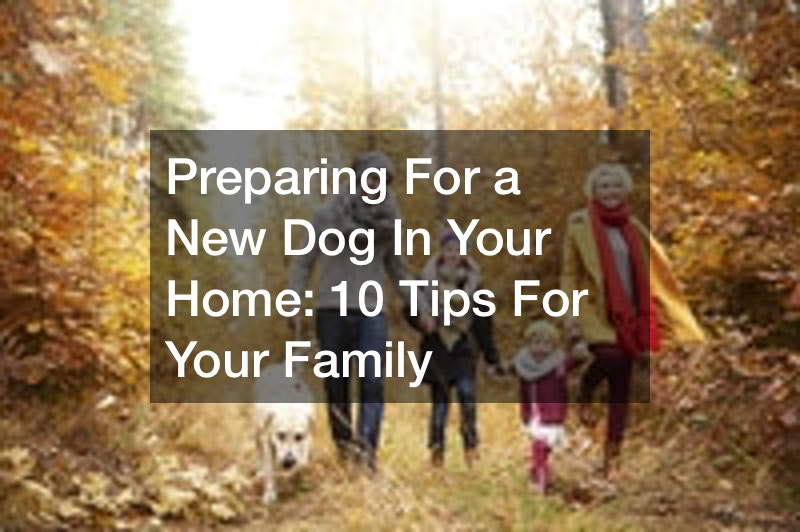The average American family consists of three people. Some families choose to expand their pack by getting a dog to share their home. Getting a pet is a major decision that requires plenty of planning. Just like with having a new baby, you will need to make some adjustments in your home to make the new changes easier on everyone, including your new pet. Here are ten tips for preparing for a new dog in your home.
Consider Installing a Fence

When preparing for a new dog, one of the first things you may want to think about is the pet’s safety. Since your dog will need to go outside frequently to relieve themselves and get some exercise, there may be a temptation for them to go exploring outside their new territory for a multitude of reasons. This can be dangerous because they could get hit by a car or get into a fight with another animal. Consider fence installation to keep them close to home and protect them from getting hurt. There are many different types of fencing choices available that can keep your new dog safe.
The type of fence you choose will depend on your breed of dog. For larger animals, you may want a fence that isn’t easy to jump over. You also want to make sure it’s not easy for them to dig under it to escape. Block off areas of your yard that you don’t want your new dog to have access to such as the garden. Put away any backyard lawn and gardening tools and keep your lawn trim to prevent fleas and ticks.
Hire Exterminators
Hiring exterminators is another thing you may seriously want to consider when preparing for a new dog in your home. Since your new pet will be spending a good portion of their day outdoors, there’s a good chance that they can carry fleas and ticks inside your home. You may want to have your home sprayed before you bring your new pet home. If you tend to get bees in your backyard, you may want to get a bee exterminator. If your new dog gets stung, they could potentially go into anaphylactic shock.
There are a few things that you can do to help pests from invading your home with your new pet. Inspect your dog thoroughly for fleas and ticks every time they spend an extended period of time outdoors. Store pet food in air-tight containers and check food and water bowls regularly for pests. Make sure your window and door screens are secure and in good repair. Clean up any spilled dog food immediately to prevent it from attracting insects and vermin. Invest in flea and tick collars and look for pet-friendly pest control products to use in your home.
Think About Your Family’s Medical Needs

You also need to think about your own family’s medical needs when preparing for a new dog in your home. Your new pet will need some time to adjust to all the new people and surroundings when you first bring it home. If you will be away for an extended period of time for medical needs such as an MRI or surgery, you’ll want to make sure something is with your pet to keep an eye on them. If a family member has extensive medical problems, your new pet can be a great source of patient comfort while they are trying to get better.
Make Your Basement Pet-Friendly
Another thing you may want to consider when preparing for a new dog in your home is basement remodeling. Some families choose the basement as a place for their new pet to have their own space or to hang out with the family with a recreation designed space. One of the most important things to focus on when making a basement pet-friendly is choosing the right flooring. While hardwood floors are easy to clean and maintain, they can be cold on your pet’s paws and easy to scratch. Carpeting can be a problem from potential leaks in your foundation and from your new pet.
Luxury vinyl flooring may be the best choice for pet owners because it stays warmer and doesn’t scratch easily. It’s also resistant to basement moisture and pet claws. Get a dehumidifier to keep moisture levels healthy for your pet. Inspect the basement for any dangerous areas and make the necessary repairs. You can turn the basement into a dog room by keeping all their supplies in the area. Make it fun by decorating it like you would a child’s bedroom with personalized wall art.
Add Fire Safety Features

One thing you may not consider when preparing for a new dog is the fire safety features in your home. Fire protection systems are crucial because pets are responsible for more than 1,000 fires every year. According to the National Fire Protection Association, an estimated 40,00 pets die annually in house fires. Make sure to have multiple smoke and carbon monoxide detectors on every level of your home. Basic fire safety also includes having your pet wear a collar with proper identification in case of emergency.
There are a few things you can do to help prevent your new dog from causing an accidental fire. If your new dog can reach the counter when they stand on their hind legs, you may want to remove the stove knobs when the appliance is not in use. Use battery operated flameless candles instead of regular candles that your new pet could easily knock over. You can get free stickers from firehouses that will alert firefighters to search for your pet if a fire does break out. Keep your new dog in rooms near main entrances whenever you leave to make it easier for firefighters to find them.
Make Your Kitchen Pet-Friendly
When preparing for a new dog, you may want to renovate your kitchen to make it more pet-friendly. As a new family member, your pet will want to hang out with you wherever you are, but that can be dangerous in certain areas like the kitchen. It may be a good idea to carve out space just for them in a corner that includes a comfy bed and their food and water dishes. You can even create a hideaway space with pull out shelves in a kitchen island to help keep your pet from getting under your feet while you’re trying to cook. Give them a cozy space near a kitchen window where they can watch all the outdoor activities by placing a sturdy bench with fluffy pillows underneath the window.
Install a doggy door in the kitchen so your pet can easily let themselves in and out as they desire. Choose pet-friendly flooring that is easy on their paws and won’t scratch easily. You may want to renovate the kitchen cabinets to make them bigger to hold all the supplies for your new pet. Use child-proof latches to keep them out of cabinets and accessing dangerous items such as knives or household chemicals. If you want to freshen up your kitchen walls with new paint, choose semi-gloss or satin paint that repels fur from sticking to the walls.
Consider All Your Family Members’ Needs

It’s important to consider all your family members’ needs when preparing for a new dog in your home. If something should happen to you, who will take care of your new dog? You may want to contact an estate planner to include your new pet in your will. You can create a pet trust that names a beneficiary to take care of your pet after you die, just like you would do for your children. The pet trust can include funds to take care of the pet’s expenses so that it’s not a burden on the rest of the family members.
Rid Your Home of Dangerous Items
One of the first things that your dog will do in its new home is explore its new surroundings. That may mean it gets into something it shouldn’t. You may want to put any dangerous items in personal storage for your pet’s safety when preparing for a new dog in your home. Put all household chemicals on high shelves and tape electrical cords to baseboards. Secure garbage can lids and remove any items your dog could potentially choke on.
You may want to purchase baby gates to keep your pets out of areas that pose the most risk for injuries, like the kitchen and bathroom. Secure clothes, shoes, and purses out of reach as these are tempting options for your new dog to want to chew on. There are certain items in your home that you will want to get rid of because they are toxic to dogs. Certain indoor plants such as lilies, philodendron, and sago palms are toxic to canines. Mothballs and rodent traps should also be removed.
If you have young children in your home, you probably have quite a few arts and crafts supplies around. Household glues can be dangerous if your new pet chews through the packaging. Several brands of adhesives contain a certain chemical that can cause the glue to swell in your dog’s throat and cause permanent damage or suffocation. Antifreeze, fertilizers, and weed killers are also dangerous to a dog’s health. You may also want to be careful about having candy within reach, as chocolate and other sweets can cause serious health issues.
Utilize a Chart to Track Pet Responsibilities

When it comes to preparing for a new dog, you’ll need to decide who will take care of them and when on a daily basis. You can utilize a chart to track pet responsibilities. The dog needs to be fed, walked, and played with. Will one person be designated these duties or how will they be divided up? Making these decisions beforehand will help avoid any confusion and stress and ensure your new pet is properly cared for.
Besides creating a chart, you may want to create a schedule as well. Decide who will be responsible for what chores on what days. Create a fixed routine for meals, bathroom breaks, and playtime. Your new puppy will need to eat three times a day and relieve themselves right after eating. The amount of exercise your dog will need will depend on its breed and personality.
Discuss Pet Safety With Your Children
Pet safety with children is crucial when preparing for a new dog. You may want to discuss pet safety with your children to keep everyone safe from harm. There are some rules you may want to put in place to guard against injuries and accidents. Children and pets should never be left in the same room unsupervised. You may want to show younger children how to pet the new dog and explain that they shouldn’t pull on their fur or tug at their tail.
Another important thing to teach your children when preparing for a new dog is learning how to approach an animal. Children should always greet an animal slowly with their palms down and maintain eye contact. Making sudden loud noises around your new pet can increase the risk of an accidental dog bite. Your child should also be aware to never approach the animal while it’s eating, sleeping, or playing on their own with toys. Another thing your child should be taught not to do is to try to take a toy or treat out of your new dog’s mouth.
Preparing for a new dog can take a lot of work. Put yourself in your new pet’s position and think about the things that could significantly affect them. Be patient as it will take them a while to adjust to their surroundings and get used to the expectations from their new family members. By following these tips, you can have peace of mind knowing that your newest family member is safely protected, comfortable, and well-loved. Start preparing your home for a new dog today.


